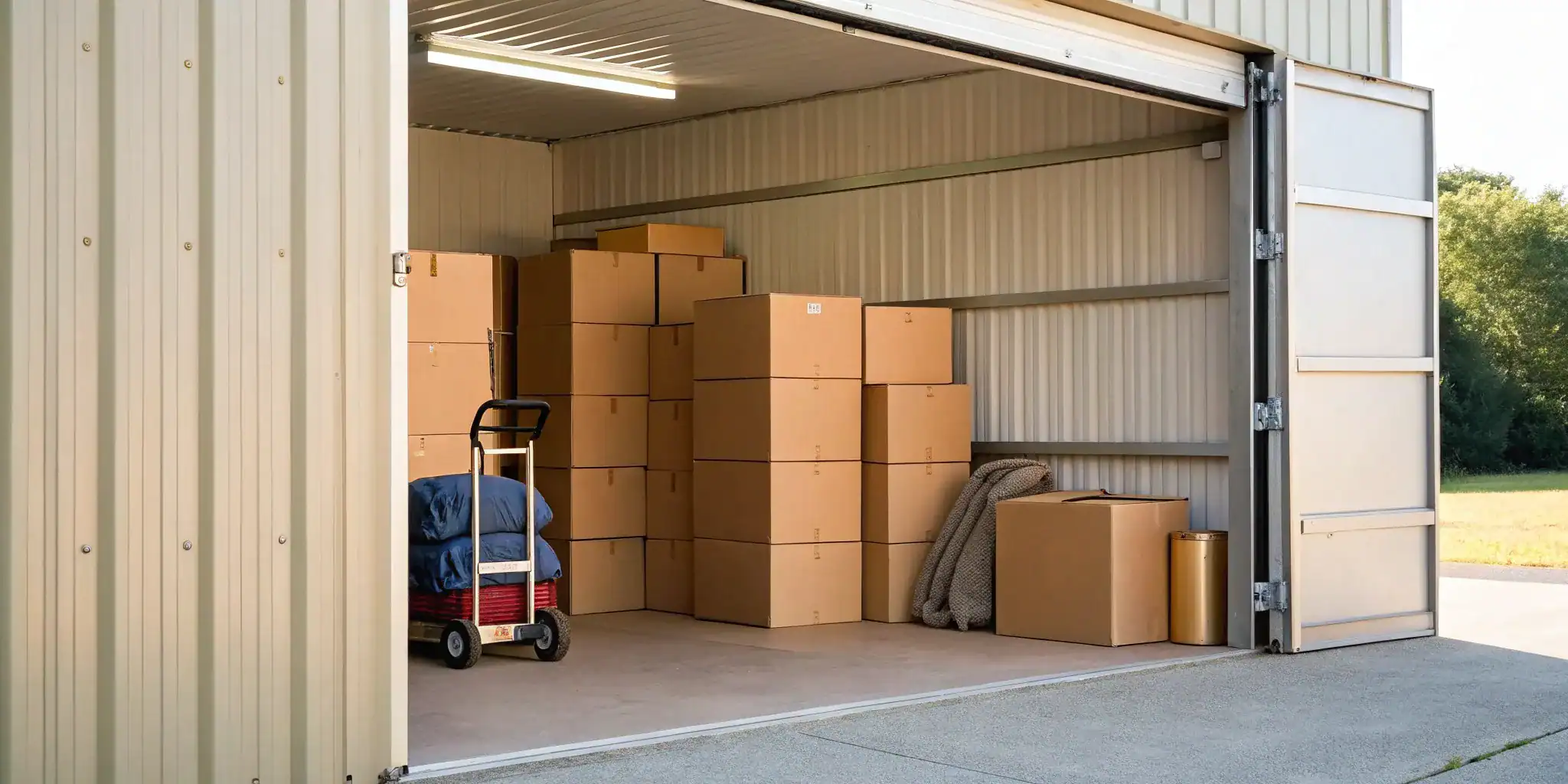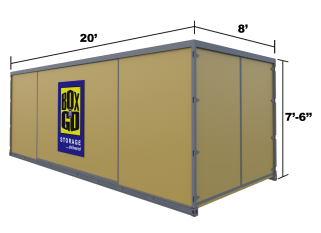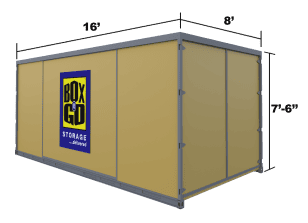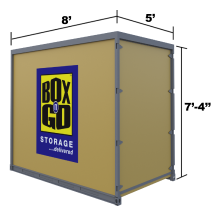Affordable Self Storage Options Near Me: Compare & Save

The traditional storage process can be exhausting. It often involves renting a truck, loading all your belongings, driving to a facility, and then unloading everything into a unit—only to do it all again later. If that sounds like a lot of unnecessary work, you’re right. Thankfully, the search for affordable self storage near me now includes smarter, more convenient options. This guide explores modern solutions, like portable containers delivered to your door, that cut the work in half. We’ll cover all your choices so you can find a storage method that saves you time, stress, and a whole lot of heavy lifting.

Key Takeaways
- Look beyond the sticker price: Your final storage cost is more than just the monthly rate. Always ask about one-time admin fees and insurance, but also look for promotions and don’t be afraid to negotiate to get the best overall value.
- Start your search online, but finish it in person: Use comparison sites to quickly find local options and create a shortlist. Then, visit your top choices to verify the facility is clean, secure, and well-managed before you commit.
- Work smarter, not harder, to save: Choose a storage method that fits your needs, like a portable container that eliminates truck rentals. Then, maximize your savings by decluttering first and packing efficiently so you only rent the space you actually need.

![]()
Let’s Talk Money: What to Expect from Storage Costs
Let’s get right to it: money. Figuring out your budget is a huge part of the storage puzzle, but pricing isn’t always as simple as a single number. The final cost depends on everything from the unit’s size to the time of year you rent. To make sure you’re getting a great deal without any surprise costs down the line, it helps to know exactly what goes into the price tag. Here’s a clear breakdown of what to expect financially when you’re looking for storage.
What Affects the Price of a Storage Unit?
The biggest factors that determine your monthly rate are the unit’s size and its features. A small 5×5 unit for a few boxes will naturally cost much less than a 10×20 unit that can hold the contents of an entire apartment. Beyond size, amenities like climate control, ground-floor access, or enhanced security systems will also add to the cost. As you compare storage options, you’ll find that prices vary quite a bit based on these features. Location is another huge factor; a facility in a dense urban center will almost always be pricier than one in a more suburban area.
Store on your driveway or inside our secure facility. Load/unload only once. Ground level access.
We Deliver
We Pick Up
We Store or Move
How Much Should You Expect to Pay?
So, what’s a typical price? It really depends on your location, but to give you an idea, the average 10×10 unit can run about $130 per month in some areas. Smaller units are obviously cheaper, sometimes starting as low as $9, while larger ones will cost more. Keep in mind that these are just averages. Storage prices can change based on demand, so it’s smart to check rates at a few different facilities before you commit. A little comparison shopping can go a long way toward finding a better deal, especially if you’re flexible with your move-in date or can snag a move-in special.

![]()
Do You Need a Climate-Controlled Unit?
This is a question that trips a lot of people up. Do you really need to pay extra for climate control? The answer is: it depends on what you’re storing and where you live. If you have items that are sensitive to extreme heat, cold, or humidity—think wooden furniture, electronics, artwork, or important documents—then yes, it’s a wise investment. A climate-controlled unit maintains a stable temperature and humidity level, protecting your valuables from warping, mildew, and other damage. For things like patio furniture or seasonal gear, you can probably skip the extra cost.
Watch Out for These Hidden Fees
Before you sign on the dotted line, make sure you ask about any additional fees. Many storage facilities charge a one-time administrative fee, which can be around $25 to $30. You might also be required to purchase their specific storage insurance, even if your homeowner’s or renter’s policy offers coverage. It’s also a good idea to ask about any potential surcharges or rate increases. Some places offer a low introductory rate that jumps up after a few months. Being aware of these potential extra costs upfront will help you create a more accurate budget and avoid any unpleasant surprises.

![]()
How to Find and Compare Storage Facilities
Finding the right storage facility can feel like a huge task, but breaking it down makes it much more manageable. Your first instinct might be to hop online and search for the cheapest price, and that’s a great start. But price is only one piece of the puzzle. You also need to think about location, security, and the condition of the facility itself. A cheap unit isn’t a good deal if your belongings get damaged or you can’t access them when you need to. It’s about finding the right balance of cost, convenience, and peace of mind.
Let’s walk through how to compare your options so you can find a place that’s not just affordable, but also safe and convenient for your needs. We’ll start with the online tools that save you time and then cover the essential checks to perform when you visit your top choices in person. This process will help you look past the flashy first-month-free offers and see which facility truly offers the best value for your situation. By the end, you’ll have a clear idea of what to look for and what questions to ask before you commit.
Use These Tools to Compare Your Options Online
Online comparison tools are your best friend when you’re starting your search. They gather information from dozens of local facilities, letting you see prices, available unit sizes, and promotions all in one place. It’s the fastest way to get a lay of the land and create a shortlist of contenders without spending hours on the phone or driving around town. These platforms give you a solid foundation for your research, but remember they are just a starting point. They often highlight promotional pricing, so it’s still important to dig deeper into what the regular rate will be. Here are a few popular options to get you started.

![]()
SpareFoot
Think of SpareFoot as an aggregator for storage units. You can plug in your zip code and see a list of facilities nearby, complete with pricing, current deals, and customer reviews. It’s a fantastic tool for getting a quick overview of what’s available in your area. You can filter by features like climate control or drive-up access and reserve a unit online without needing a credit card upfront.
SelfStorage.com
Similar to SpareFoot, SelfStorage.com is another marketplace focused on helping you find and compare local storage options. It clearly lays out the different unit sizes available at each facility, from a small 5×5 to a large 10×20, so you can easily see who has what you need. The site is straightforward and focuses on helping you find an affordable unit quickly.
20’ Container – all weather. 16’ Container – all weather. 8’ Container – all weather.
Perfect for 3-bedroom residence.
5-7 rooms, furniture, appliances, etc.
Perfect for 2-bedroom residence.
3-5 rooms, furniture, appliances, etc.
Modular – works for any need.
Each fits 1-1.5 rooms.
MoveBuddha
Even moving experts point to these kinds of tools. Moving resource sites like MoveBuddha often recommend using online storage marketplaces to save time and money. However, they also offer a great reminder: these sites don’t always list every single facility. Think of them as a powerful starting point, not the final word.
Why You Should Always Visit in Person
After you’ve made a shortlist online, it’s time for a field trip. A website can show you curated photos, but it can’t give you a true feel for the place. Visiting in person allows you to see if the facility is as clean and secure as it claims to be. Is the property well-lit? Does the staff seem helpful and professional? You can also inspect the actual unit you’d be renting to check for any signs of pests, water damage, or disrepair. This step is crucial for traditional facilities where you’ll be leaving your belongings for weeks, months, or even years. It’s your chance to trust your gut.

![]()
Check for Security and Convenient Access Hours
You’re trusting a facility with your possessions, so security should be a top priority. During your visit, look for key features like perimeter fencing, electronic gate access, good lighting, and visible security cameras. Ask the manager about their security protocols. Beyond security, consider convenience. Check the facility’s access hours. Can you only get to your things during business hours, or do they offer 24/7 access? Factoring in the time and transportation costs of driving back and forth is important, especially if you plan on visiting your unit frequently. Make sure the hours work with your schedule, not against it.
Look for a Clean and Well-Kept Facility
A clean facility is a well-managed facility. When you visit, pay attention to the details. Are the hallways, elevators, and common areas tidy? Is the property free of trash and debris? A commitment to cleanliness suggests the management is proactive about maintenance, which reduces the risk of issues like pests or mold that could damage your items. If the office is messy and the grounds look neglected, it’s often a red flag that your belongings might not be in the best hands. You want a place that shows they care about their property, because it means they’ll care about yours too.
How to Get the Best Deal on Your Storage Unit
Finding the right storage unit is one thing, but getting it at a price that feels right is the real win. The good news is that storage pricing isn’t always set in stone. With a little bit of research and the right timing, you can find some fantastic deals that make a big difference in your budget. It’s not about being cheap; it’s about being smart with your money.
Think of it like booking a flight or a hotel—prices can change, and promotions are always popping up. The key is to know what to look for and when to ask for it. From snagging a first-month-free special to understanding how the season affects rates, a few simple strategies can lead to significant savings. Let’s walk through exactly how you can secure the best possible deal on your storage unit.

![]()
Spot the Most Common Deals and Promotions
One of the easiest ways to save money is to keep an eye out for new customer promotions. Many storage facilities offer eye-catching deals like “first month free” or “50% off your first three months” to attract new renters. These offers are usually front and center on their websites or on comparison sites like SelfStorage.com. When you’re in the initial research phase, make a note of which companies are offering the best introductory rates. Keep in mind that these deals can sometimes vary by the size of the unit, so if you have some flexibility, you might find a better promotion on a slightly larger or smaller space.
Don’t Be Afraid to Negotiate Your Rate
You might be surprised to learn that storage unit prices can sometimes be negotiable. While you can’t just name your own price, you can certainly ask if there’s any wiggle room. It never hurts to call the facility manager and ask if they can price-match a local competitor or if they have any unadvertised specials. You have the most leverage if you’re planning to rent for a while. Many facilities are willing to offer a discount if you commit to a long-term contract, as it guarantees them business. Being polite and simply asking, “Is this the best rate you can offer?” can open the door to a better deal.
Decide Between Long-Term and Short-Term Rentals
Before you sign a contract, get clear on how long you’ll actually need the storage. Your timeline is a major factor in what type of storage will be most cost-effective. If you only need storage for a month or two during a home renovation, a flexible, short-term option like a portable container might be your best bet. However, if you’re looking to store items for a year or more, a traditional facility might offer a lower monthly rate on a long-term lease. The goal is to avoid paying for a long-term contract you don’t need or getting stuck with high monthly fees when a longer commitment would have saved you money.

![]()
How Seasons Affect Storage Prices
The storage industry has a peak season, just like travel. Most people move during the spring and summer, which means demand for storage units goes way up—and so do the prices. If you have the flexibility to wait, you can often find much better rates during the off-season in the fall and winter. If your moving date is fixed during a busy time, try to book your unit as far in advance as possible to lock in a better price. Storage prices fluctuate, so checking rates regularly in the weeks leading up to your move might help you spot a price drop or a new promotion.
Think Outside the Box: Alternatives to Traditional Storage
If the thought of renting a truck, playing Tetris with your boxes, and hauling everything to a storage facility sounds exhausting, you’re not alone. For years, that was the standard process, but it’s a model that asks you to do all the hard work—twice. You load the truck, drive it, unload it into the unit, and then do it all again when you need your things back. This process is time-consuming, physically demanding, and frankly, outdated.
Thankfully, traditional self-storage isn’t your only choice anymore. Modern storage solutions are built around flexibility and convenience, saving you time, stress, and a whole lot of heavy lifting. These alternatives often bring the storage to you, letting you pack on your own schedule without the pressure of a truck rental deadline. Whether you’re moving, renovating, or just need to clear out some space, it’s worth looking at options that fit your life, not the other way around. From containers delivered to your door to sharing space with a neighbor, there are smarter ways to store your stuff.
We deliver the best storage solutions. No gimmicks:
No Truck to rent…EVER!
Load ONCE Storage Solution!
Pay Only for the Space You Use!
(if storing at our facility)Secure, Climate-Friendly Facility!
EASY Drive-Up Access!
(if storing at our facility)
Portable Storage Solutions
Portable storage is a game-changer for anyone who values efficiency. The concept is simple: a company delivers a storage container right to your driveway. You load it up at your own pace—over a day, a weekend, or however long you need. When you’re done, the company picks it up and either moves it to your new home or stores it in a secure facility. This completely removes the need to rent, drive, and unload a moving truck, cutting your workload in half. It’s one of the most efficient and affordable storage options available, especially if you want to simplify your move or decluttering project.

![]()
Box-n-Go
With Box-n-Go, a portable storage container is delivered right to your location, giving you the freedom to pack on your own timeline. Once your container is loaded, we pick it up and store it at our secure, indoor facility. You get ground-level access to your belongings whenever you need it, combining the convenience of at-home packing with the security of professional storage.
Box-n-Go Portable Storage Unit Sizes









PODS
As a well-known name in the industry, PODS also provides portable containers delivered to your home. They offer a few different container sizes to fit your needs. After you pack, they can store the container at one of their facilities or transport it to your next destination, making them a flexible option for both moving and storage.
U-Pack
If you have a smaller amount to move or store, U-Pack’s 7-foot Relocubes could be a great fit. They are a cost-effective solution, especially for shorter-distance moves or temporary storage needs. This option is particularly useful if you don’t need the space of a larger container and want to keep your costs down.
Personal & Business Storage
Student Storage
Local & Nationwide Moving
Packing & Loading Help
Moving Boxes & Supplies
1-800-PACK-RAT
1-800-PACK-RAT offers sturdy, weatherproof containers in several sizes. A big plus is that they often include 30 days of storage with your rental, which is perfect if your moving dates don’t line up perfectly. This built-in flexibility can be a lifesaver during a chaotic move or renovation project.
Peer-to-Peer Storage Options
Think of peer-to-peer (P2P) storage as the Airbnb for your belongings. This approach connects you with people in your community who have extra space to rent out—like an empty garage, a spare room, or a basement. You can often find lower prices and more flexible arrangements than with traditional facilities. It’s a great way to find a hyper-local spot for your things. Just be sure to clarify details like access hours and security upfront, as these can vary widely from one host to another and may not offer the same protection as a professional facility.

![]()
Storage Marketplaces
If you love to compare prices and find the best deal, storage marketplaces are for you. These are websites that gather quotes and availability from many different storage facilities in your area, including both traditional and portable options. Instead of visiting multiple websites or making a dozen phone calls, you can see your choices laid out in one place. This saves you a ton of research time and helps you quickly spot the best rates and promotions available near you. It’s a smart first step for anyone who wants a clear overview of the market before making a decision.

![]()
Smart Ways to Save Money on Storage
Getting the best price on storage isn’t just about finding a promotion—it’s also about being smart with the space you rent. A little planning before you load up your unit can significantly reduce your monthly bill. You can often get by with a smaller, less expensive unit just by using a few practical strategies. Let’s walk through some of the most effective ways to keep your storage costs down without sacrificing peace of mind.
Pack Efficiently to Maximize Your Space
The most common mistake people make is paying for space they don’t actually use. Before you book a unit, take a rough inventory of what you plan to store. This will help you choose the right size from the start. Many companies offer a storage unit size guide to help you visualize how your belongings will fit. When you pack, use boxes of uniform sizes. They are much easier to stack securely than a random assortment of mismatched boxes. This simple step makes your unit safer to move around in and creates a stable base for using all the available space.
Use Vertical Space to Your Advantage
Don’t forget to look up! The height of your storage unit is valuable real estate. You can dramatically increase your storage capacity by stacking items from floor to ceiling. Place your heaviest, sturdiest boxes on the bottom and work your way up with lighter items. If you have furniture, consider disassembling larger pieces like bed frames and tables to store them vertically against a wall. Investing in some simple, freestanding shelving units can also be a game-changer, allowing you to organize smaller items and keep them accessible without having to unstack everything to find what you need.

![]()
Consider Sharing a Unit
If you only have a handful of items to store, renting an entire unit might feel like overkill. A great way to cut costs is by sharing a storage unit with a friend, family member, or trusted neighbor. You can split the monthly fee, making it much more affordable for everyone involved. Just be sure to set some ground rules first. Have a clear conversation about how you’ll divide the space, who will have access, and how payments will be handled. Putting your agreement in writing can help prevent any misunderstandings down the road and keep things running smoothly for both of you.
Declutter First, Store Later
The cheapest item to store is the one you don’t have. Before you pack a single box, take a serious look at your belongings and decide what’s truly worth keeping. A good rule of thumb is the “six-month rule”: if you haven’t used an item in the last six months and it has no sentimental value, it might be time to let it go. The most cost-effective solution is always getting rid of unnecessary items through donation, selling, or recycling. You’ll save money on storage and feel lighter in the process. Why pay to store things you no longer need or want?
What Are Other Customers Saying?
One of the best ways to get a feel for a storage company is to see what other people have to say about their experience. Think of it as getting advice from a friend who’s already been through the process. Reviews give you the inside scoop on everything from customer service to facility cleanliness, helping you look past the marketing promises to see how a company really operates. Taking a few minutes to read what others have shared can save you a lot of headaches down the road and help you find a place you feel truly confident about.
Where to Find Reviews You Can Trust
Start by looking at reviews on third-party sites like Google and Yelp, as these platforms offer a broad range of customer feedback. You can also check specialized comparison websites, which often aggregate reviews and facility details in one place. The key is to get a well-rounded picture from multiple sources. Before you commit to a facility, it’s a smart move to read customer reviews to understand the real-world experiences of past renters. Look for patterns in the comments—if multiple people mention fantastic customer service or, conversely, a recurring issue with billing, pay attention.

![]()
Spot These Red Flags in Customer Reviews
As you read, learn to spot reviews that might be misleading. Some negative feedback stems from common but incorrect assumptions. For example, a reviewer might complain about a facility’s rules without realizing they were breaking a standard policy, like trying to store flammable materials. There are many self-storage misconceptions that can lead to a poor experience if you aren’t aware of them. Also, be wary of overly general complaints. A comment like “the location felt unsafe” might be a personal feeling rather than a reflection of a genuine security problem, as the idea that all storage unit locations are dangerous is a common myth.
How to Balance Price with Quality Service
The cheapest option isn’t always the best value. Use reviews to weigh cost against the quality of service you’ll receive. A slightly more expensive unit at a clean, secure facility with great customer service is often a much better deal than a bargain-basement unit at a place with terrible reviews. Before you book, take the time to compare prices and amenities to ensure you’re getting what you pay for. Look for reviews that mention helpful staff, easy access, and overall security. These details are just as important as the monthly rate and will make your storage experience much smoother.
What If You Need to Store Something Special?
Sometimes, your storage needs go beyond packing up seasonal decorations or extra furniture. You might be looking for a place to keep your prized convertible safe for the winter, a secure spot for your small business inventory, or a temporary home for your belongings during a chaotic renovation. The good news is that the world of storage has solutions for these situations, too. Self-storage isn’t a one-size-fits-all service, and understanding your specific requirements is the first step to finding the right fit. Whether you’re dealing with oversized vehicles, sensitive business documents, or the short-term shuffle of moving, there’s likely a storage option designed for you. Let’s look at some of the most common special storage scenarios and what you should know about each one.

![]()
Storing Your Vehicle, RV, or Boat
If you have a vehicle, RV, or boat that needs a home, you’re in luck. Many self-storage facilities offer specialized storage options for these larger items, providing everything from outdoor parking spaces to covered spots or even fully enclosed garages. An outdoor space is the most budget-friendly choice, but a covered or enclosed unit offers better protection from sun, rain, and snow. Before you commit, ask about security features like gated access and surveillance cameras. Also, check the access hours to make sure you can retrieve your vehicle when you need it. Proper preparation is key to keeping your vehicle in good condition while it’s stored.
Storing Business Inventory and Documents
Self-storage is a fantastic resource for entrepreneurs and small business owners. It’s not just for personal items; businesses can benefit from renting storage units to keep inventory, equipment, and important documents safe and organized. An e-commerce seller might use a unit as a mini-warehouse for products, while a contractor could store tools and materials securely between jobs. If you’re storing sensitive files or electronics, a climate-controlled unit is a smart investment to protect them from temperature extremes and humidity. This approach can be much more affordable than leasing commercial warehouse space, giving your business a flexible way to manage its physical assets.
Finding Short-Term Storage for a Move or Renovation
Home transitions are stressful enough without tripping over boxes or worrying about your furniture getting covered in drywall dust. Short-term storage can be a lifesaver during these periods, allowing you to store your belongings securely while you move or renovate. Many facilities offer flexible, month-to-month rental agreements, making it easy to find a temporary solution without getting locked into a long contract. Using storage can help you declutter your home before putting it on the market, or simply clear out a room to make way for a renovation project. This flexibility gives you the breathing room you need to get the job done right.

![]()
Ready to Decide? A Final Checklist
You’ve done the legwork, compared your options, and are close to making a choice. This final checklist will help you lock in your decision with confidence, ensuring there are no surprises down the road. Think of this as your last walkthrough before you sign on the dotted line, making sure every detail is just right for your needs and budget.
Review These Key Factors
Before you commit, take one last look at the most important variables. First, confirm the unit size. It’s tempting to get more space “just in case,” but accurately assessing your needs will keep you from paying for air. Next, lay out the final price quotes from your top choices. Prices can differ significantly, so comparing them side-by-side is crucial. Finally, make sure you’ve accounted for any promotional offers. A great introductory deal can seriously impact your first few months of costs, so be sure it’s factored into your budget. A quick review of these points ensures you’re getting the right space at the best possible price.
Box-n-Go Portable Storage Unit Sizes









Ask These Questions Before You Sign Anything
With a specific facility or service in mind, it’s time to get crystal clear on the details. Don’t hesitate to ask direct questions—it’s your money and your belongings, after all. Start by asking, “Are there any other discounts available?” You never know if there’s an unadvertised special for paying quarterly or setting up autopay. Dig into the security measures and confirm the access hours work for your schedule. This is also a great time to check recent customer reviews to see what current renters are saying. Lastly, make a final call on climate control. If you’re storing items sensitive to heat or humidity, this is a non-negotiable feature.
Read the Fine Print: What to Look for in Your Agreement
The rental agreement is your most important document, so give it a thorough read. Scan for any one-time administrative fees, which are common but should be understood upfront. You’ll also want to know the policy on late payments, the notice required for moving out, and whether you need to purchase their insurance or if your homeowner’s policy is enough. If you’re opting for a portable container that will be left on your property, check if any local permits are required for street or driveway placement. Clarifying these details now prevents unwelcome surprises later.

![]()
Related Articles
- How much does it cost to rent a portable storage unit
- Do You Need Climate-Controlled Self Storage? – Box n Go Storage and Moving
- Find Cheap Self Storage Near Me: A Practical Guide – Box n Go Storage and Moving
- 5×10 Self Storage Units: What Fits & How Much it Costs – Box n Go Storage and Moving
- Traditional vs. Portable Storage – Box n Go Storage and Moving
Frequently Asked Questions
How do I know if I really need climate control? The simplest way to decide is to ask yourself: would I be comfortable leaving this item in a hot car or a cold garage for a few months? If the answer is no, you should probably opt for climate control. This applies to things like wooden furniture that can warp, electronics that can be damaged by extreme temperatures, and important papers or artwork that are sensitive to humidity. For more durable items like garden tools or seasonal gear, you can likely save the money and skip it.
Is portable storage more expensive than a traditional unit? It can seem that way at first glance, but you have to look at the total cost and effort. While the monthly rate for a portable container might be comparable to a traditional unit, you completely eliminate the cost and hassle of renting a moving truck. You also save yourself the work of loading and unloading your belongings twice—once into the truck and again into the unit. When you factor in the time, fuel, and physical labor you save, portable storage often provides better overall value.
What’s the best way to avoid surprise fees? The key is to ask direct questions before you sign anything. When you talk to the manager, ask for a complete breakdown of all potential charges. Specifically ask about a one-time administrative fee, mandatory insurance policies, and their policy on rate increases. A reputable company will be transparent about these costs. It’s also smart to read your rental agreement carefully to see what it says about late fees or the notice required before you move out.
How far in advance should I book my storage unit? If you can, try to book your unit at least two to four weeks ahead of time, especially if you plan to move during the busy spring or summer months. Demand is highest during this peak season, so booking early helps you lock in a better rate and ensure you get the unit size you need. If your timing is flexible, you can often find better deals during the fall and winter when demand is lower.

![]()
Can I just use my homeowner’s insurance instead of buying the facility’s policy? Sometimes, but you need to check the details with both your insurance provider and the storage facility. Many homeowner’s or renter’s insurance policies offer some coverage for off-site belongings, but it might be limited. Some storage facilities also require you to purchase their specific insurance regardless of your personal coverage. Your best bet is to call your insurance agent to confirm what your policy covers and then ask the storage facility manager what their requirements are.

